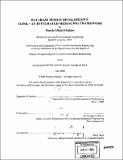Database design development : i-LINK, an integrated messaging framework
Author(s)
Chahine, Pamela Michel, 1979-
DownloadFull printable version (8.611Mb)
Alternative title
i-LINK, an integrated messaging framework
Other Contributors
Massachusetts Institute of Technology. Dept. of Civil and Environmental Engineering.
Advisor
George A. Kocur.
Terms of use
Metadata
Show full item recordAbstract
For many people, online communication has meant a plethora of communication media - emails, instant messages, blogs, etc. Often this has led to clustered desktop displays and ineffective integration between communication media. Software development teams are adversely affected by the lack of integration between applications. When project managers, software developers and clients come together to work on one or more projects, certain communication and managerial considerations and requirements become apparent. A server-based Integrated Messaging Framework (IMF) provides all communication media messages with a common messaging format. i-LINK, an intelligent client application uses IMF to send, receive, log, and store messages from different communication channels. There are contrasting database models from which to choose when designing the IMF data model (i.e.: flat file, relational, object oriented, objected relational). However, the IMF was designed using a relational data model due to the stability it offered, the protection provided through referential integrity and constraints, as well as other unique benefits. When considering the services that IMF is designed to provide, certain existing messaging standards are conceptually useful to analyze before designing the IMF data model. The RFC 2778 provides a universal Instant Messaging (IM) data model which can be mapped to provide such services as presence and instant messaging. Microsoft Outlook, a Messaging Application Programming Interface (MAPI), presents a data storage mechanism. The IMF database model integrates concepts from existing messaging standards and refines the integration of different communication media while acting as a central repository.
Description
Thesis (M. Eng.)--Massachusetts Institute of Technology, Dept. of Civil and Environmental Engineering, 2004. Includes bibliographical references (leaf 74).
Date issued
2004Department
Massachusetts Institute of Technology. Department of Civil and Environmental EngineeringPublisher
Massachusetts Institute of Technology
Keywords
Civil and Environmental Engineering.